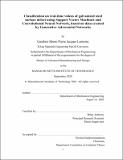Classification on real-time videos of galvanized steel surface defect using support vector machines and convolutional neural network, based on data created by generative adversarial networks
Author(s)
Lemoine, Gauthier Bruno Pierre Jacques.
Download1263359029-MIT.pdf (3.393Mb)
Other Contributors
Massachusetts Institute of Technology. Department of Mechanical Engineering.
Advisor
Brian Anthony.
Terms of use
Metadata
Show full item recordAbstract
With the current surge of Industry 4.0 in high-end technology industries, enabling complete digitalization and machine-to-machine interaction, and with the vulgarization of its techniques, commodity-based industries are now attracted by its associated benefits, such as higher flexibility, faster troubleshooting, and increased productivity and quality. In this vein, this project explores the use of video images to identify surface defects on galvanized steel tubes in real-time during production. To meet the criteria of accuracy, robustness, and speed, a conventional Support Vector Machine was first tested, and proved to be moderately accurate at 91% and moderately-robust, but satisfying the real-time constraint. In order to increase accuracy, different conventional and custom architectures of Convolutional Neural Networks were then used, through both transfer learning and scratch learning, and showed higher robustness and accuracy at 98% but lower speed. To decrease the inference time, techniques such as pruning and binarization were tested. While the binarized architecture showed a significant drop in accuracy, pruning showed a 30% compression ratio for the same accuracy. In parallel, to increase the robustness, different Generated Adversarial Networks architectures were designed to generate synthetic images of the defects to nourish the datasets. It was then shown that mixed synthetic datasets increased the robustness of the CNN classification models.
Description
Thesis: M. Eng. in Advanced Manufacturing and Design, Massachusetts Institute of Technology, Department of Mechanical Engineering, September, 2020 Cataloged from the official PDF of thesis. Includes bibliographical references (pages 66-68).
Date issued
2020Department
Massachusetts Institute of Technology. Department of Mechanical EngineeringPublisher
Massachusetts Institute of Technology
Keywords
Mechanical Engineering.